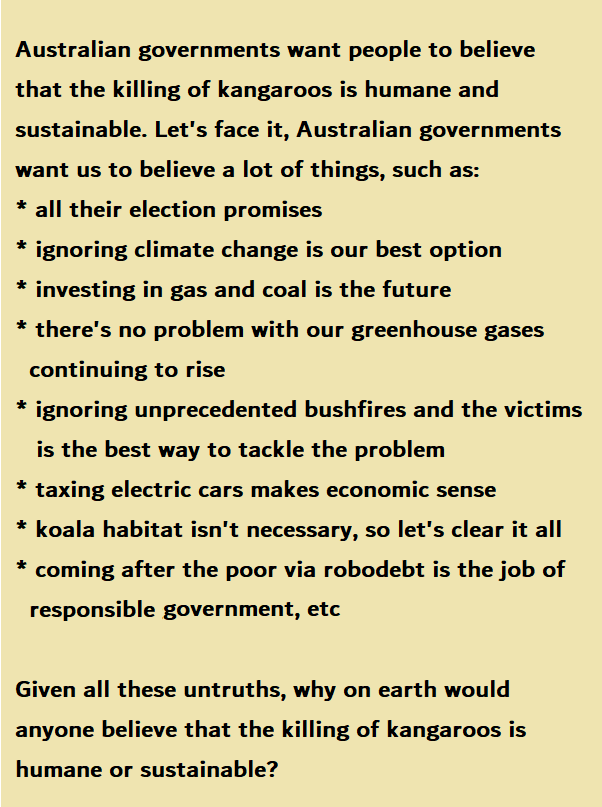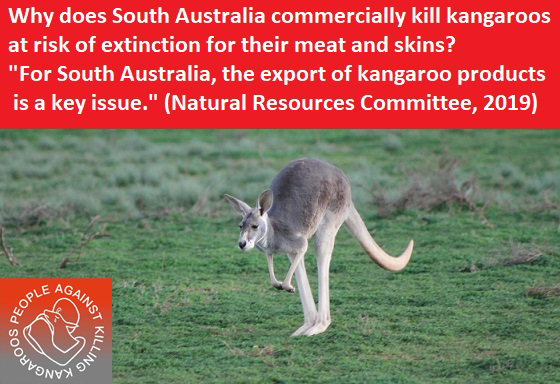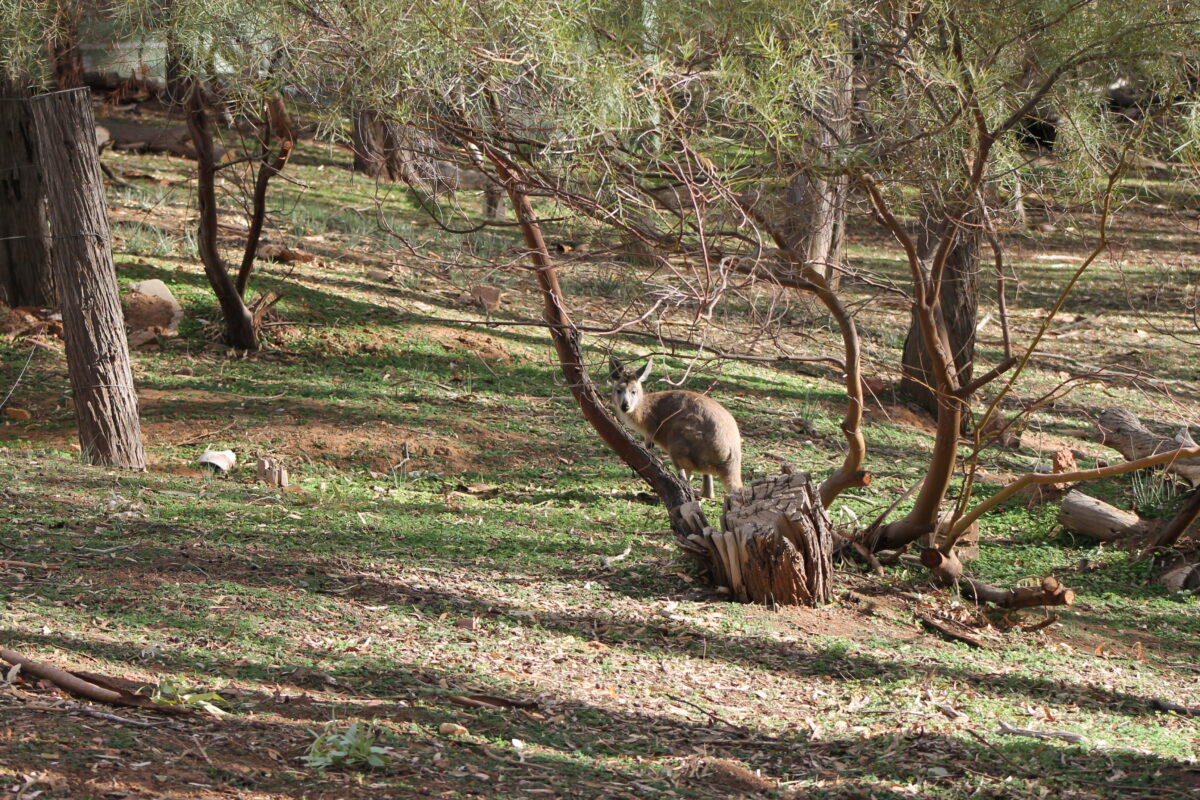
Australian governments manipulate figures to give the impression that the commercial killing of kangaroos is sustainable. Australian governments hide the truth because they don’t want people to know that kangaroo populations at risk of extinction are being killed for their meat, body parts and skins or that localised extinctions are already happening. What you read in this blog is just the tip of the iceberg.
Science Ignored
Multiple scientific reports conclude that no killing should occur when kangaroo populations are less than 10 kangaroos per square kilometre.
Density of unharvested populations in these simulations rarely fell below a minimum of 5 individuals/sq km. Although the critical minimum density is not clearly defined, populations below 2/sq km would generally be considered at risk of extinction. On this basis, Figure 19 suggests that any option resulting in an average long-term density of less than 10/sq km should be rejected since in all such cases the minimum density is likely to fall below the critical level. (Kangaroo management options In the Murray-Darling Basin Hacker et al, 2004, Page 37)
Situation Analysis Report Update on Current State of Scientific Knowledge on Kangaroos in the Environment, Including Ecological and Economic Impact and Effect of Culling (Penny Olsen & Tim Low) was prepared for the Kangaroo Management Advisory Panel March 2006. The report states:
Within individual management zones, there is no need for a quota when kangaroos are above a certain density. For example, quota-free at (fictional) densities greater than 20 kangaroos/km², a quota imposed at densities between 10–20/km² and no harvesting at all below 10/km². Such thresholds would protect kangaroo populations from improving economics in the harvesting industry whereby it became profitable to harvest a greater proportion of the population than is currently economically viable. (Situation Analysis Report Update on Current State of Scientific Knowledge on Kangaroos in the Environment, Including Ecological and Economic Impact and Effect of Culling, Penny Olsen & Tim Low 2006, Page 96)
In light of the above research, kangaroos shouldn’t be killed in Western Australia or South Australia under any circumstances. Only 1 out of 7 zones in Victoria has a grey kangaroo population greater than 10 kangaroos per square kilometre. In New South Wales only 1 out of 9 red kangaroo populations is greater than 10 kangaroos per square kilometre, zero wallaroo populations are greater than 10 per square kilometre and only 7 out of 14 grey kangaroo populations are greater than 10 kangaroos per square kilometre. In Queensland, one out of 21 red kangaroo populations, one out of 21 wallaroo populations and 5 out of 21 eastern grey populations is greater than 10 kangaroos per square kilometre. The majority of Australia’s commercially slaughtered kangaroo populations shouldn’t be killed for any reason.

Killing Kangaroos at Risk of Extinction
The Science
Density of unharvested populations in these simulations rarely fell below a minimum of 5 individuals/sq km. Although the critical minimum density is not clearly defined, populations below 2/sq km would generally be considered at risk of extinction. On this basis, Figure 19 suggests that any option resulting in an average long-term density of less than 10/sq km should be rejected since in all such cases the minimum density is likely to fall below the critical level. (Kangaroo management options In the Murray-Darling Basin (Hacker et al, 2004, Page 37)
The Reality
Red kangaroo populations generally considered at risk of extinction are commercially killed in 7 out of 17 zones in Queensland, 6 out of 9 zones in New South Wales, 6 out of 11 zones in South Australia and 3 out of 3 zones in Western Australia.
Eastern grey kangaroo populations generally considered at risk of extinction are commercially killed in 10 out of 19 zones in Queensland.
Grey kangaroo populations generally considered at risk of extinction are commercially killed in 3 out of 14 zones in New South Wales and 3 out of 7 zones in Victoria.
Western grey kangaroo populations generally considered at risk of extinction are commercially killed in 6 out of 14 zones in South Australia and 3 out of 3 zones in Western Australia.
Wallaroo populations generally considered at risk of extinction are commercially killed in 18 out of 20 zones in Queensland. New South Wales and South Australia only count wallaroo populations every three years, so current populations are unknown.

Biologically Impossible Increases
The reproduction rate for red kangaroos is a maximum of 13.5% under good conditions. The reproduction rate for grey kangaroos is a maximum of 10% under good conditions. (https://www.kangaroosatrisk.net/2-biology–population-ecology.html)
Commercial killing was suspended in Cobar in New South Wales during 2019 and 2020 due to this kangaroo population being considered at risk of extinction.
In 2020, red kangaroo numbers allegedly increased by 184%. The biologically impossible increase allowed the NSW Office of Environment & Heritage to re-open Cobar to commercial killing. The 2021 kill quota is 17,422, which is 17% of the alleged estimated population.
In 2020, grey kangaroo numbers allegedly increased by 504%. The biologically impossible increase allowed the NSW Office of Environment & Heritage to re-open Cobar to commercial killing. The 2021 kill quota is 4,421, which is 10% of the alleged estimated population.
Commercial killing was suspended in Tibooburra in New South Wales during 2019 and 2020 due to this kangaroo population generally being considered at risk of extinction.
In 2020, red kangaroo numbers allegedly increased by 153%. The biologically impossible increase allowed the NSW Office of Environment & Heritage to re-open Tibooburra to commercial killing. The 2021 kill quota is 20,046, which is 10% of the alleged estimated population.
Kangaroos in New South Wales defied science and a 3-year drought by miraculously increasing throughout the state. Red kangaroos allegedly increased by 124.7% in the Lower Darling, 103.2% in Bourke, 129.1% in Coonabarabran and 137% in Griffith South. Grey kangaroo numbers allegedly increased by 63.5% in Narrabri.

In spite of the biologically impossible increases, New South Wales kangaroo populations have declined by 40% since 2016. The biologically impossible increases suggest that kangaroo populations have declined by much more than 40%.
Since 2016, Western Australian kangaroo populations have declined by 55%, South Australian kangaroo populations have declined by 50% and Queensland kangaroo populations have declined by 36%.
In 2014, a report was prepared by the Australian Government Department of the Environment for submission to the California Department of Fish and Wildlife and included the 2013 and 2014 estimated total population of the commercially killed kangaroos in Australia. Coincidentally, during these two years, the number of western grey kangaroos increased by 116% in New South Wales, 33% in South Australia and 78% in Western Australia. In New South Wales, eastern grey kangaroos increased by 41%. In Queensland, red kangaroos increased by 42%, eastern grey kangaroos increased by 25% and wallaroos increased by 72%. In South Australia, western grey kangaroos increased by 33%.
A study of the estimated kangaroo populations in Australia over the last 20 years suggests one of three things – the method used is woefully inadequate and flawed, or the humans managing kangaroos couldn’t manage a sock drawer, or the figures are as fictional as the Harry Potter books. Maybe all three statements are true.

